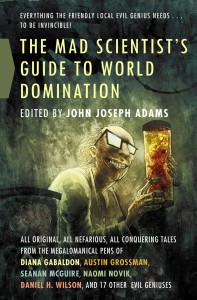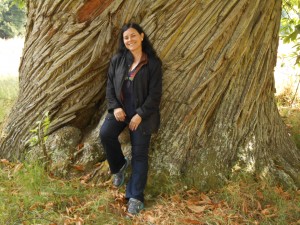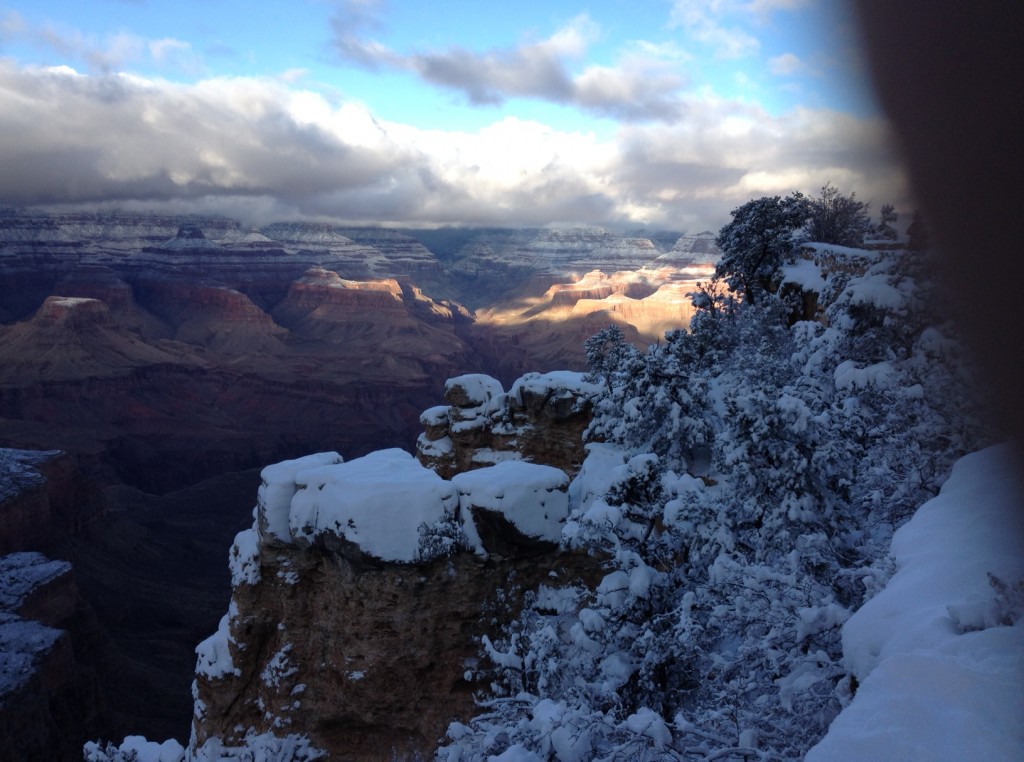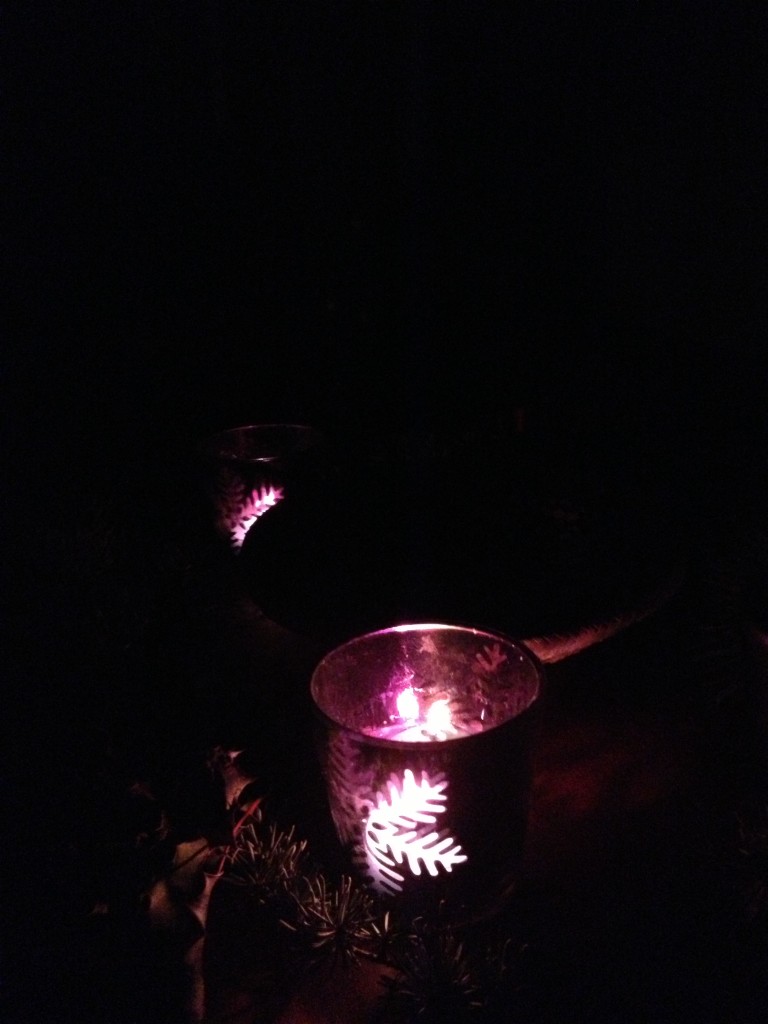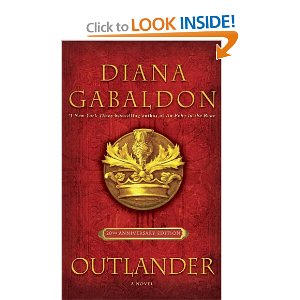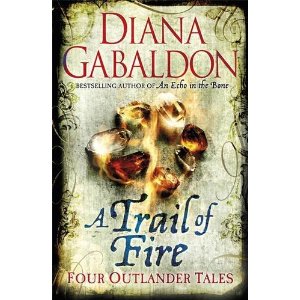Our wait is nearly over, and through the shadows and difficulties that beset our lives, we see the glow of everlasting light.
Excerpt from WRITTEN IN MY OWN HEART’S BLOOD. Copyright © 2012 by Diana Gabaldon [Please don’t repost or reproduce this blog entry or its contents, but certainly you may link to it if you’d like to! See below.]
 Jamie was sitting as I’d left him, alone by our tiny fire, now burnt down to a bed of red ember furred with ash. And yet… not quite as I’d left him. I stopped abruptly, a little way outside the glow of the embers, fascinated by the look on his face.
Jamie was sitting as I’d left him, alone by our tiny fire, now burnt down to a bed of red ember furred with ash. And yet… not quite as I’d left him. I stopped abruptly, a little way outside the glow of the embers, fascinated by the look on his face.
He was entirely still, still as a waiting hunter, still as the stump he sat on. And yet his face was alive, his eyes looking into the fading coals but somehow beyond them, not abstracted at all. He was seeing something, and I felt the hairs lift on my arms, so slowly that I felt each one rise. And yet, the sense of him was one of absolute peace. The hurry I’d felt a moment before had vanished as I watched him. He might have been alone in some vast wilderness—alone, save for whoever he was talking to in the silence that surrounded him.
I didn’t move. I couldn’t take my eyes from his face. I too stood apart from the chaos of the camp for a moment, and heard silence. Silence filled with presence, a sense of quiet joy.
Then Jamie drew breath and closed his eyes, shoulders relaxing. The sounds of the night and the racket of the camp came back. I drew breath, too, and he heard me, for his head came up, his eyes opened, and he smiled at me and reached out his hand.
“Mo nighean donn,” he said softly, and kissed the hand I put in his, his breath cool on my skin.
“What were you doing just now?” I asked, as softly, and laid my free hand to his cheek, stroking back the ruddy hair behind his ear. “Praying?”
His mouth twitched, but he looked away, self-conscious.
“Och, no. I was just talkin’ to Ian.”
I blinked, glancing automatically over my shoulder, searching for Ian’s tall, rangy figure among the fires and smoke, even as I realized that wasn’t who he meant.
“No, the elder Ian,” Jamie said, smiling as he caught my look. “My friend, aye?”
“Do you do that often?” I asked curiously, sitting down beside him on a convenient rock. He turned toward me, and I saw the puff of white at his shoulder. “You have a split in the shoulder seam of your coat. Take it off, why don’t you, and I’ll fix it. You can’t be going into battle with your sleeve hanging off; General Washington wouldn’t like it.”
He gave a small snort at that, but obligingly stood up and wriggled out of the heavy coat, while I dug the hussif out of my pocket and found a needle threaded with something dark—it was impossible to distinguish black and indigo in the shadows.
“Aye, I suppose I talk to Ian often,” he said matter-of-factly, sitting down again. “Just the odd word now and then, when something minds me of him. But I dreamed of him last night, of when we were in France, so he was still wi’ me today.”
I looked sharply at him. I generally knew when he dreamed—always when he dreamed about war—but hadn’t noticed any disturbance of his sleep the night before. In fact, he’d slept like the dead until the wee hours, when he’d suddenly rolled over, gathered me into his arms, and fallen instantly back asleep, his face buried in my bosom.
“Aye, it was odd,” he said thoughtfully, as though knowing what I was thinking. “The closer we come to—” He waved a hand, encompassing the army around us, “—the more terrible the dreams get. Things comin’ back, aye? And yet last night… I was sittin’ by a fire with Ian, in France, and the rest of the band around us, and we were sharpening our dirks, sharing an oilstone. I kent we were readying ourselves for a fight, but I wasna at all concerned about it, nor was Ian. I was only glad to have him there, by my side,” he added softly.
I’d seen him once, standing in nothing but his shirt at a spring on Fraser’s Ridge, call on Dougal MacKenzie for help, and seeing him now in his shirt, pale against the dark, reminded me. That encounter had held something of the strange stillness of what I’d just seen, but wasn’t the same.
“Did you—ask Ian to… er… come with you?” I asked, cautious, but curious. “Just now, I mean. Into battle?”
He blinked at that, surprised.
“No,” he said, and smiled, half-embarrassed. “It’s—och, it sounds foolish to say.”
“You don’t think I’d laugh, do you?” I asked, smiling too. I stabbed the needle into the fabric of the coat, and took his hand. It was hard, but smooth-palmed, and his fingers curled slowly round my own.
“It’s only—sometimes I find myself at peace, ken. No for any reason; just there it is, the gift of a moment when bein’ alive is all there is, and all I could want. Does that happen to you, Sassenach?” His head turned toward me, features now fading into darkness, but I caught the brief shine of his eyes, heard his beard-stubble rasp softly against his stock.
“Yes,” I said, after a moment. “Yes, it does. Sometimes in the most peculiar circumstances. But not often… and out of the blue.” Like this one.
“Out of the blue,” he repeated, liking the phrase. “Aye, that’s how it is. Ye canna make it happen; all ye can do is live it—and if ye’re lucky, remember it now and then.”
He paused and cleared his throat.
 “Sometimes… well, it strikes me sometimes, the dead must be happy and at peace as spirits in heaven, but still—maybe they miss bein’ an animal. What it is to touch, and taste, and breathe and all. And so… I was just sitting here, feeling full of good food, wi’ the taste of decent beer on my tongue, thinkin’ how sweet it was to sit down and rest, and how the night air felt soft on my face and… aye, well. Sometimes there’s a good moment and I… well, I ask one o’ my dead in, ye might say. To share it with me.”
“Sometimes… well, it strikes me sometimes, the dead must be happy and at peace as spirits in heaven, but still—maybe they miss bein’ an animal. What it is to touch, and taste, and breathe and all. And so… I was just sitting here, feeling full of good food, wi’ the taste of decent beer on my tongue, thinkin’ how sweet it was to sit down and rest, and how the night air felt soft on my face and… aye, well. Sometimes there’s a good moment and I… well, I ask one o’ my dead in, ye might say. To share it with me.”
He squeezed my hand gently, let it go, and put his arm around me, drawing me in so that my head lay against his chest. I could hear the slow thump of his heart and the gentle gurgling of his stomach, smell sharp mustard and beer on his breath, smell his sweat and the sun of the day in his skin.
“I dinna always feel them nearby—but tonight I kent Ian was with me.”
I hoped he didn’t feel the seep of my tears through the damp cloth of his shirt, but he did, for he drew back a little and with a small “Tck” sound, cupped my face in his hands, wiped the tears away with this thumbs, then bent and kissed me, soft and slow.
“Ye live in all my moments, Sassenach,” he whispered. “And the taste of you is aye on my tongue.”
[end section]
[And many, many thanks to Barbara Schnell, my Most Excellent German translator and mistress of the German Diana Gabaldon website, for the wonderful notion of the Advent “candles.” Danke!]
[Second image: “In which Otis Sees a Great Light”]
Copyright © 2012 by Diana Gabaldon. All rights reserved.
As stated above, please don’t repost or reproduce this post, excerpts of my work, and images, but certainly you may link to this blog entry if you’d like to! Copy and paste this text version of the link (URL):
http://www.dianagabaldon.com/2012/12/happy-fourth-sunday-of-advent/
Thanks!
This blog entry was last updated on Monday, December 24, 2018, by Diana’s Webmistress.
Posted on December 23, 2012 9:02 AM
